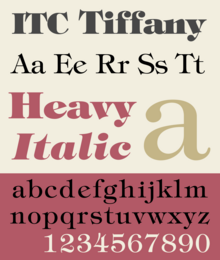ITC Tiffany
The Tiffany - after the type foundry , which they brought out, often referred to as ITC Tiffany called - is a roman - Font with humanistic character. It was designed by the American type designer Ed Benguiat . Usually assigned to the Venetian Renaissance antiquity in terms of type , the font, published in 1974, became one of the most widespread advertising fonts of the 1970s.
Emergence
The ITC Tiffany is one of those classic designer writings which the New York type designer Ed Benguiat for - also in New York-based type designer label font International Typeface Corporation designed (ITC). With ITC Souvenir (1970) - as well as with his participation in the creation of the ITC Avant Garde , which also came onto the market in 1970 - Benguiat had already earned a reputation as a (co-) designer of commercially successful typefaces. The ITC Tiffany was born in 1974. Her design was not a (complete) designerische creation. Rather, the character image based on two earlier writings: the 1884 in Philadelphia -based metal type foundry Mackellar Smiths & Jordan put on the market Ronaldson and Caxton , a further 1,904 for the first time laid hot type -Antiqua.
ITC Tiffany , published in 1974, was initially given three and later four weights . There are currently four italic variants each. The distinctive features of Tiffany are the accentuated serifs , often in an inclined position , the calligraphic linework in the execution of the individual characters, and the contrasts in stitch strength , which are unusually strong for a Renaissance antique of the Venetian type. The latter were less present in the two templates - the Ronaldson and the Caxton . Another distinguishing feature is the shape of the lowercase "e": unlike in the two reference fonts, this is not horizontal, but inclined - a typical characteristic of fonts of the Venetian type from the second half of the 15th century.
Although equipped for paragraph text inserts, the ITC Tiffany made a name for itself primarily as advertising font - that is, when designing visually outstanding elements. In retrospect, it is considered one of the most important advertising fonts of the 1970s. The two ultra-bold variants (heavy and heavy italic) advanced to become a distinctive "text mark", which is particularly popular for slogans and headline design. A well-known lettering designed at ITC Tiffany is the logo of the 1997 Quentin Tarantino film Jackie Brown .
Digital versions
As a well-known classic font, ITC Tiffany is represented in the libraries of many well-known font distributors - such as those of Linotype , Monotype and Adobe . The two Tiffany templates Ronaldson and Caxton have now been reissued as digital fonts . The Caxton was redrawn by Lee Usherwood and reissued as ITC Caxton in 1981 . A digital version of the Ronaldson , created in 2006, is distributed by the Toronto- based label Canada Type.
Individual evidence
- ↑ The 100 Best Fonts of All Time. 23rd Avant Garde ( Memento of the original from July 20, 2012 in the web archive archive.today ) Info: The archive link was inserted automatically and has not yet been checked. Please check the original and archive link according to the instructions and then remove this notice. , FontShop (ed.): The 100 Best Fonts of All Time, HTML version, accessed September 23, 2018.
- ^ ITC Tiffany . Ralf Herrmann, Typografie.info, October 21, 2014.
- ↑ For current expansion, see brief information and credits on ITC Tiffany at MyFonts.com, accessed on September 23, 2018 (Engl.)
- ↑ Type class assignment see: Venezianische Renaissance-Antiqua , Wolfgang Beinert , typolexikon.de, August 1, 2018.
- ↑ Chimera or Reality? Advertising literature from the seventies . Günter Schuler , Publishing Praxis, Edition 12/2001 (part of the booklet "Invers"; PDF)
- ↑ Jackie Brown , design-is-fine.org, accessed on September 23, 2018 (Engl.)
- ↑ Brief information and credits on Ronaldson and ITC Caxton ; each at MyFonts.com, accessed on September 23, 2018 (Engl.)

